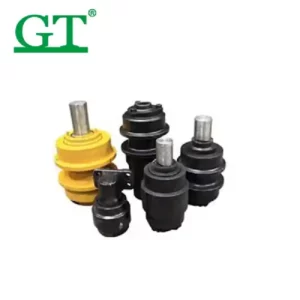The blade float feature in some excavator carrier rollers enhances grading and leveling tasks by allowing the blade to “float” or follow the contours of the terrain without applying downward pressure.
Here’s how it improves grading and leveling:
- Adaptability to Terrain: The blade float feature enables the excavator’s blade to adapt to the natural contours of the terrain by allowing it to move freely up and down without resistance. This flexibility ensures that the blade maintains constant contact with the ground, even on uneven or undulating surfaces, resulting in more accurate grading and leveling.
- Reduced Surface Damage: By floating over the terrain instead of exerting downward pressure, the blade minimizes surface damage and disturbance during grading and leveling tasks. This is particularly beneficial for delicate surfaces or finished landscapes where excessive pressure could cause soil compaction, erosion, or other damage.
- Improved Finish Quality: The blade float feature helps achieve a smoother and more consistent finish by preventing the blade from digging into the ground or creating ridges and furrows. It allows the blade to skim over the surface, removing high spots and filling in low spots to achieve a uniform grade and level.
- Enhanced Operator Control: Operators can maintain better control over grading and leveling operations with the blade float feature engaged. By allowing the blade to float freely, operators can focus on steering and maneuvering the excavator without constantly adjusting blade height or pressure, excavator carrier roller manufacturers resulting in smoother and more efficient operation.
- Time and Labor Savings: The blade float feature streamlines grading and leveling tasks by reducing the need for manual adjustments and corrections. Operators can complete jobs more quickly and with less effort, saving time and labor costs while achieving high-quality results.
- Versatility: The blade float feature enhances the versatility of the excavator by enabling it to perform a wide range of grading and leveling tasks in various terrain conditions. Whether working on rough terrain, soft soil, or finished surfaces, operators can rely on the blade float feature to deliver consistent and precise results.
- Compatibility with Attachments: The blade float feature is compatible with various blade attachments, including straight blades, angle blades, and tilt blades. This versatility allows operators to customize their grading and leveling setup to suit specific job requirements and achieve optimal performance in diverse applications.
Overall, the blade float feature in excavator carrier rollers improves grading and leveling tasks by adapting to terrain contours, reducing surface damage, enhancing finish quality, providing operator control, saving time and labor, offering versatility, and compatibility with different blade attachments. It enables operators to achieve precise and efficient results in a wide range of grading and leveling applications.
What measures are in place to protect the hydraulic cylinders of a excavator top roller from damage?
Protecting the hydraulic cylinders of an excavator top roller is essential to ensure the reliable and safe operation of the equipment. Here are several measures commonly implemented to safeguard hydraulic cylinders from damage:
- Cylinder Guards: Installing cylinder guards or shields around the hydraulic cylinders provides physical protection against impact, abrasion, and debris. These guards are typically made of durable materials such as steel or heavy-duty plastics and are designed to deflect or absorb impacts that could otherwise damage the cylinders.
- Positioning and Mounting: Properly positioning and mounting hydraulic cylinders within the excavator’s structure minimizes their exposure to potential hazards. Mounting cylinders in protected areas of the machine’s frame or undercarriage reduces the risk of direct impact from external objects and debris during operation.
- Seal Protection: Hydraulic cylinder seals are vulnerable to damage from debris, moisture, and contaminants, which can compromise their integrity and lead to hydraulic fluid leaks. Implementing seal protection measures such as wipers, boots, or covers helps shield seals from external elements, extending their lifespan and preventing premature failure.
- Routine Inspection and Maintenance: Regular inspection and maintenance of hydraulic cylinders are essential for identifying signs of wear, damage, or malfunction early on. Establishing a preventive maintenance schedule that includes visual inspections, excavator top roller manufacturers fluid level checks, and seal replacements ensures that cylinders remain in optimal condition and reduces the likelihood of unexpected failures.
- Proper Operation Techniques: Training equipment operators in proper operation techniques helps minimize the risk of hydraulic cylinder damage. Encouraging operators to avoid overloading, abrupt movements, or excessive force during operation reduces the strain on cylinders and prolongs their service life.
- Load Limit Monitoring: Monitoring the load limits and capacity ratings of hydraulic cylinders ensures that they are not subjected to excessive loads or pressures beyond their design specifications. Implementing load monitoring systems or safety devices that provide real-time feedback on cylinder loads helps prevent overloading and potential damage.
- Environmental Protection: Protecting hydraulic cylinders from exposure to harsh environmental conditions such as extreme temperatures, corrosive substances, or abrasive materials is crucial for their longevity. Implementing environmental protection measures such as insulation, corrosion-resistant coatings, or protective covers helps shield cylinders from environmental hazards.
- Emergency Response Planning: Developing and implementing emergency response plans for hydraulic cylinder failures ensures a prompt and effective response in the event of damage or malfunction. Training personnel in emergency procedures, including cylinder shutdown, fluid containment, and equipment evacuation, helps minimize the potential impact of cylinder-related incidents.
By implementing these measures, equipment owners and operators can effectively protect hydraulic cylinders from damage and ensure the reliable and safe operation of excavator top rollers. Regular inspection, maintenance, and training are key components of a comprehensive hydraulic cylinder protection strategy that enhances equipment performance and longevity.
